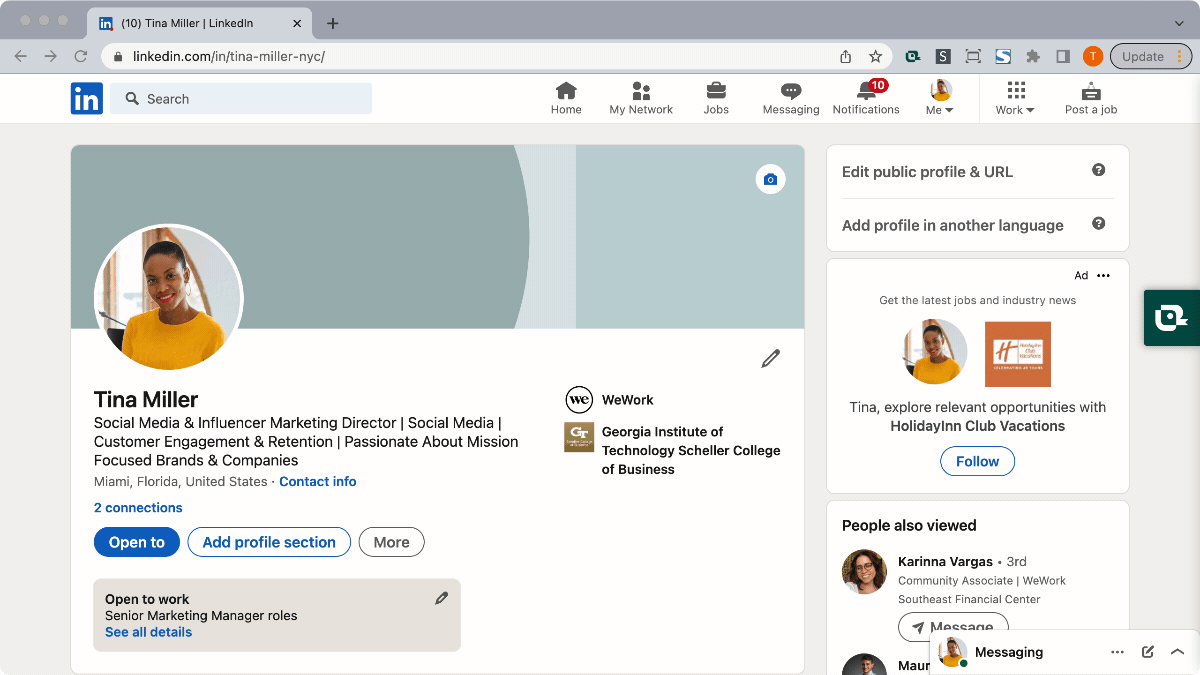Do you feel stuck because you're scared to leave a job? Are you looking for some direction or guidance? Even though this situation may be stressful, it's an excellent opportunity to take a step back and assess where you are in your life and career—and where you'd like to go next.
Before we dive into detailed advice on how to navigate this situation, here are some signs that you might feel scared about leaving a job that pays well:
- You haven't discussed the idea with anyone or gotten another perspective yet.
- You feel guilty for considering other employment possibilities.
- You're worried that a job or career change could disrupt your life in unexpected ways.
- You keep talking yourself out of taking any action to explore other jobs and opportunities.
All of these feelings are common and may be justified, but they can also limit your potential and stand in the way of your career development. We'll start by addressing some of the concerns that often arise for people. Then, we'll walk you through eight steps to help you holistically evaluate your situation in order to chart a path forward.
Concerns About Leaving
- Typically, when someone is afraid to leave a high-paying job, compensation is one of the main anxiety-inducing factors. A highly lucrative position with the potential of a bigger salary often seems like it will be difficult to replicate elsewhere.
- For most people, change and the unknown are scary concepts, which may make them stay in that comfortable job. When someone is thinking, “I want to leave my job but I'm scared,” the prospect of a different and unpredictable future is often a significant source of that fear.
- Social circumstances, varying levels of support, and peer pressure can also contribute to someone's hesitancy to leave a cushy gig. This may involve family members, friends, colleagues, or managers. Work can be deeply connected to a person's identity and seeking a new job can trigger anxiety and fear concerning the loss of self or diminished status. (However, the opposite can also be true.)
If you're grappling with some of these thoughts, it can be helpful to break down all of the variables in order to ground yourself and gain some perspective. The following 8-step inquiry exercise will empower you to make the best possible decision about whether you stay put in a current job or start seeking a new role. You'll have a good chance to uncover pros and cons, but there are no right or wrong answers. Your goal should simply be to gain understanding and clarity, so you can decide what to do.
Step 1: Determine Total Compensation
As a first step, collect as much compensation data as you can about your current role using Teal's Compensation Checklist. Remember, compensation is often more than just wages or salary. It might include healthcare coverage, company stock or equity, bonuses, a 401(k) match, a pension, a discretionary spending budget, etc.
Since total compensation can be substantially more than just your salary, you'll want to determine the dollar equivalent of all of your compensation sources combined. For example, imagine this (somewhat simplified) scenario:
You make an annual salary of $90,000 and have health insurance that pays 100% of your premiums and 50% for your two dependents. (Your healthcare premiums are $500 per month per person.) You also get a phone allowance of $50 per month and have a 100% 401(k) match of 4% of your salary.
Salary ($90,000) + employer portion of healthcare ($12,000) + 401(k) match ($3,600) + phone allowance ($600) = total compensation ($106,200)
This means that your total compensation—not factoring in taxes—is $106,200. (You could also subtract the healthcare premium cost you'd incur, which would bring you down to $100,200.)
The math can get complicated, so you'll likely need to create a spreadsheet to organize your calculations. It'll take some time to locate all the numbers and plug them in, but the time is well spent because it will enable you to do an apples-to-apples comparison with other opportunities should you choose to seek them out.
Understanding what you need is really important before you embark into the next phase of your career journey. To help you do that, we've built a simple little spreadsheet tool, the Compensation Projector, that helps you calculate your budget.

Step 2: Review Job Title, Function, and Duties
Next, examine the more qualitative aspects of your job. What is your title? What are your duties? What function do you play on your team and within the larger organization? Identifying these pieces of information will help you evaluate whether or not you're interested in continuing in the same field and type of work or would be interested in something different and pursuing more fulfilling work. It also serves to give you a jumpstart on updating your resume with new skills, bullet points, and other areas outlining your professional experiences (which we'll get to in a moment).
Step 3: Assess Company and Job Market
Once you have a clear sense of your role and the total compensation, research the company.
- What do they do?
- How are they situated in the market?
- Are they growing sustainably?
- Have they done layoffs recently?
- Do you believe in their values and mission?
- Would you consider working for a competitor?
- Would you want to stay in the same industry?
- Are you contemplating a move to a parallel role or a more drastic change?
You can keep track of the research you conduct in Teal's Job Application Tracker. Tips and guidance are offered of where and how to conduct research.

If you don't feel aligned with the company's vision or strategic direction, or if the company isn't on stable financial footing, you might have to accept that it could be time for a departure. On the other hand, if the company is doing well and you predict that they'll be successful, it might be worth sticking around with the status quo.
Step 4: Reflect on People and Team Culture
After assessing the HR and business aspects of your role, it's critical to reflect on the people and team culture. At the end of the day, a company is simply a collection of people working together toward a common goal, and those people make a huge impact on your experience as an employee.
- How is your relationship with your manager?
- How are your relationships with other co-workers?
- How's your work-life balance?
- Do you feel heard, respected, challenged, and supported by the people you work with?
- Can you be yourself at work?
- Does the company foster a culture of constructive feedback, growth, and collaboration?
The answers to these questions are probably the most important factors in your decision-making process. No amount of money or status can justify career stagnation or navigating a toxic culture.
If you're energized by working with your team and feel supported by your colleagues and manager, that's an indication that you might have a future there moving forward. If your workplace is unsupportive, hostile or toxic, you should start drawing up an exit plan immediately. For many people, the reality will lie somewhere in between, so people and culture won't be the sole deciding factor when it comes time to stay or go.
Step 5: Get Outside Input
When making important decisions, it's always a good idea to talk to trusted friends or relatives to get their perspectives. Pick several people who are very familiar with you and your work. They should also be people who you trust to provide direct and honest feedback. Try to steer clear of people with potential bias — like a co-worker who will miss you if you leave.
If you don't have any formal, documented feedback to review, consider asking other people for their viewpoints on your skills using the 360 Work Styles Assessment. Current and former coworkers, friends, and even family can all help you get a more realistic grasp on what you offer.

Step 6: Build a Decision-Making Model
After going through all the steps above, you may still be on the fence. If that's the case, you can create a decision-making model to clarify everything. Looking at a pro/con or positive/neutral/negative list is usually easier than trying to organize all the thoughts swirling around in your head.
Your model doesn't have to be fancy. It can be written on a piece of paper or entered into a spreadsheet. Make categories for each variable you want to consider. These could include compensation, job satisfaction, co-workers, manager, impact, company culture, growth potential, and whatever other factors are relevant to your situation. Then, assign a value to each category. You can use pro/con, positive/neutral/negative, or a number scale. When they are calculated, the results may surprise you, or they may reinforce your initial gut instinct.
You can use Teal's Values Workbook to determine your vision for your career journey. Your vision statement will crystallize your values, your motivations, and it will be this statement that you can continue to go back to, to help you make career decisions.

Step 7: Consider Intangibles
All quantitative models are inherently imperfect because they can't adequately factor in every single variable or capture nuance. There are two qualitative factors that you may want to consider, especially if the model-building exercise doesn't give you a clear-cut signal.
A significant factor in career development is opportunity cost. The dictionary definition of this concept is “the loss of potential gain from other alternatives when one alternative is chosen.” This means that any decision you make about how to spend your time means that you can't be doing something else. In other words, taking a job or staying in a job eliminates your ability to take other opportunities (unless they are part-time and flexible).
Another factor is risk tolerance. This varies widely between people and depends on a variety of circumstances. Be honest with yourself about the level of risk you can reasonably tolerate and use that to inform your thinking. What's the best-case, middle-case, and worst-case scenario if you leave? What about if you stay? How do you feel about each?
Step 8: Make the Decision
If completing your model ends up convincing you that it's best to stay in your current role, you're done (but you should revisit this topic periodically to make sure you still feel the same way).
If you decide it's time for something new, the real work begins. This decision—and new reality—may feel overwhelming, intimidating, or emotional, but that doesn't mean you're making the wrong choice.
To make the transition easier, try using our Resignation Letter Generator to craft a professional, personalized resignation letter in seconds. It's free, simple to use, and designed to save you time during this pivotal moment.
“I left a job that I loved. After putting in my notice, I shut my computer and had a good cry. I knew that it was the right decision. I felt stagnant in my role, and I'd recently realized that taking my career to the next level required a move. But it was still hard. And it didn't immediately get easier when I started a new role. Years later, I'm proud of younger Brianna for doing the hard thing. It's okay to be afraid of what the next chapter holds for you. You unlock a new level of confidence when you learn to embrace being uncomfortable.”
Get Your Ducks in a Row
After you've decided you're going to pursue new opportunities, you need to define what those are. This is a process of looking inward and figuring out what makes you tick and what you really want. To help you better understand yourself, Teal offers a free Work Styles assessment you can take.
We recommend that you do this to do a little bit of introspection and self-awareness work on your work style by taking Teal's Teal’s Work Style Assessment. This is a quick self assessment to help you build your confidence in your career journey.

The assessment also offers supplementary training to help you interpret your results. Use the work style tool. Go to it, read it, read the job searching section, and read about interviewing. Hopefully that will give you some tips to better understand your style as you navigate your career journey.

The book Designing Your New Work Life by Bill Burnett and Dave Evans may also be helpful.
Once you're confident about the direction you're headed, you'll want to update your job search materials. This includes your resume, LinkedIn profile, cover letter template, and any other professional assets (like a portfolio website).
You can use Teal's free AI Resume Builder tool to create an optimized resume that will maximize your chances of getting noticed by recruiters and hiring managers.
Don’t forget to update your resume with your latest experience and achievements! The job of your resume is to get you in the door. Optimizing it will help you land interviews for the next opportunities that excite you. Teal’s free AI Resume Builder can help you keep your Work History up to date and help you write metric-driven bullet pointsusing our Assistant tool.

If you make the decision to pursue other job opportunities, you want to make sure you present yourself as a strong candidate. Analyzing and utilizing the keywords in the job description will help you stand out.
Use Teal’s AI Resume Builder to quickly compare the skills and keywords in the job posting to those in your resume. Make sure to add any relevant experience to your customized resume and to your application answers.
.gif)
There's also a LinkedIn Profile Review tool you can use to make sure your profile stands out and has the desired impact.
A great way to check your LinkedIn profile is to download Teal’s Free Job Search Chrome Extension which includes an automated LinkedIn Profile Review. Once you install the extension, just go to your profile page and click on the Teal logo. You’ll see a list of recommendations on how best to optimize your profile and can make updates as needed.

Take the Next Steps
The job search can last many months, so it's important to prepare for a marathon as opposed to a sprint. Luckily, there are lots of things you can do along the way to steadily improve your competitiveness as a candidate. Reach out to people in the types of roles you're interested in and schedule informational interviews to learn about their work.
If you don't personally know anyone in that specific space, this might come in the form of cold outreach. Cold outreach can be a bit uncomfortable, so we've created communication templates for sending cold outreach messages in Teal's Job Application Tracker as a starting point.

Start learning about whatever topics you predict will be relevant in your new role. This can include reading books, listening to podcasts, and joining online communities.
Build relationships with recruiters so you're on their radar when new roles open up. Seek out volunteer or freelance projects to build your skills and continue learning. And, finally, familiarize yourself with general as well as industry-specific job boards and start submitting applications for roles of interest.
Start your search with Teal’s Job Board to explore opportunities tailored to your next career move, whether you’re looking for tech roles, creative positions, or something entirely new.
The process of re-evaluating your work and career path can be intense and challenging, but it will always provide valuable new insights on who you are and how you can reach your maximum potential and lead a fulfilling life. It's never a bad time to explore how you're feeling and what's out there. When a new path reveals itself, commit to investing in yourself and your future so you can meet the moment. You won't regret it.
If you plan on starting your job hunt after leaving your current job, manage your job search with Teal, a free Job Application Tracker that lets you track and store important job hunting details.











